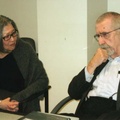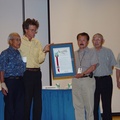Read Part 6 >>
Why Did They Renounce?
After its publication in 1946, The Spoilage remained for many decades the primary source on Tule Lake. This seminal work cited allegations of harassment by pro-Japan groups that led to the mass renunciations, using field notes written after the war ended, September 25, 1945 and December 19, 1945.1 Renunciants who sought to regain their U.S. citizenship from the Department of Justice recognized that the desired explanation for their renunciation was to blame the pro-Japan groups for pressure and coercion. Government records declassified in recent decades and interviews with renunciants, however, document more complex motives, also noted in The Spoilage, that affected the decision to renounce.
Japanese researcher and professor Teruko Kumei, who, with colleague Yoko Murakawa, interviewed over a hundred expatriate renunciants, questions the way that pro-Japan groups have been characterized as forcing others to join their ranks and pushing others into renouncing. She offers an alternative explanation based on her substantial research of principal figures in the Segregation Center:
It seems more likely that those organizations were formed and won large memberships because of a prevailing embitterment among the ‘segregees:’ embitterment which the “segregees” had had since the days of forced removal from their home on the west coast, and which had become aggravated since their arrival at the Tule Lake Center. Some of them, like Wakayama, demanded immediate repatriation as a means of protest, while some others, like Z.T., did so to maintain their ethnic pride. Still others claimed that the “segregees” should not be drafted. All of these were taken as appropriate reason for joining the group by supporters of the pro-Japan organizations.2
In an interview, Masaru Hashimoto, secretary of the central committee of the Hokoku Seinen-dan, told Kumei that it would have been harmful to the organization if membership had been forced upon unwilling “loyals,” and that the organization had no role in the mass renunciations.
It’s not true. It’s a fabrication after the war. It’s a fabrication to restore citizenship. But I tell you, we never threatened anyone. I can assure you of that. The Hokoku Seinen-dan never ever threatened anyone to join, or threatened to punish them if they didn’t. We were sincere in our desire to become good Japanese. That is what we wanted. That’s all.3
Another member of the central committee and president of a ward branch, Hidekazu Tamura, says that there was no forced membership, and insists that members were too sincere in their activities to threaten anyone for membership. He believed that people of different principles should be excluded to maintain the harmony of the organization.4 Satoshi Yoshiama told Project Attorney Noyes, “We closed the membership,” explaining that they were receiving 20 to 30 inquiries a day, but regarded these individuals as insincere about their devotion to Japan.5
There are a multitude of reasons other than the “pressure-group” explanation that provide understanding of what caused so many people to renounce their citizenship. The second generation Nisei, who were U.S. citizens, described intense pressure from their non-citizen Issei parents who, because of their race, were legally ineligible for U.S. citizenship. The Issei parents believed that if the Nisei children renounced their U.S. citizenship, they could keep the entire family—now alien enemies—together in case the Issei were deported to Japan after the war.6 Because of the abnormal isolation of those imprisoned in the Tule Lake Segregation Center, some dismissed news of allied victories as propaganda; they believed that Japan was winning the war and that discarding U.S. citizenship would help them settle in postwar Japan.
With the end of racial exclusion, the imprisoned population at the Segregation Center believed they were being dumped into hostile American communities that did not want them, with no home, no job, and no money. With little hope for security in the immediate future, renouncing became the strategy to delay reentry to the inhospitable white world outside the barbed wire. All that was required to remain at Tule Lake was signing a paper giving up one’s worthless citizenship. Since most inmates were impoverished by the removal and years of incarceration, remaining at Tule Lake meant having a roof overhead, three meals a day, and conserving money for an uncertain future.7 The combination of such factors, reiterated Rosalie Hankey, produced a state of mind comparable “to a crowd of persons who believed that they are about to be bombed, rush to shelters, and finds there officials whose statements they interpret as ‘Renounce your citizenship or you cannot enter.’”8
Many viewed renouncing as a response to mistreatment and non-acceptance in America, as a way to demonstrate one’s worth and dignity as a proud Japanese. Many planned to go to Japan as soon as possible. Instead of being a cringing, second-class American, Masaru Hashimoto stated, he was “too proud to be submissive to the government while incarcerated in the camp.”9 Another renunciant, Minoru Kiyota, who wrote of abuse by Army guards and “shaved-heads,” reflected, “It was the government of the United States that threw me into this place. Why should I want to be a citizen of a country like that? I decided to do the one last thing I could do to express my fury toward the government of the United States. I would renounce my U.S. citizenship.”10
“Renunciation was not a criminal act,” wrote Kiyota. “It was simply the last act of defiance available to human beings who found themselves in an intolerable situation. Granted, it was a stupid thing to do. But that stupidity was fostered by years of persecution under the U.S. government. Long years of rage and accumulated resentment spawned that stupidity.”11
Some young Nisei men, initially classified as 4-C enemy aliens and then reclassified to draft eligible 1-A, felt little reason to fight for a country that imprisoned them and their families behind barbed wire and placed them under martial law. In response to misinformed rumors that they would be drafted, they renounced to refuse and protest military service. For people with no legal forums available to them, renouncing became one of the few ways they could protest their treatment.
Tokio Yamane, a former Fresno high school athlete who served as athletic director of the Hokoku Seinen Dan, was tortured and imprisoned in the stockade bullpen—a tent with no floor, no heat, and no medical treatment. He remembered the abuse and the guards shouting “You, Jap.” His efforts to gain help from the Spanish Embassy failed because he was an American citizen, and therefore denied the protection provided an alien enemy. “They wouldn’t allow me to be an American. Then, other than becoming a Japanese what else could I be? American society rejected me, would not accept me.” Yamane said he could not expect to have any hope in America and that becoming a Japanese seemed the only logical response to the rejection and suffering and the shame that he endured. After he decided to live as a Japanese national, “the suffering and the shame became a badge of honor and self-esteem.”12
Notes:
1. Thomas and Nishimoto, pages 253-55.
2. Kumei, page 82.
3. Kumei, page 81. Interview and translation by author, 25 February, 1995, Ibaraki Prefecture.
4. Kumei, page 81. Interview and translation by author, 25 February, 1995, Ibaraki Prefecture.
5. RG 210, Entry 48, Box 274, NND 802054, Tule Lake Relocation files 423-425.3. Notes from meeting between Mr. Noyes and the Resegregation group regarding information on the renunciation of American Citizenship. Friday, December 1, 1944.
6. Noboru Shirai, Tule Lake: An Issei Memoir, page 152-53.
7. Shirai describes this group as mainly the original Tule Lake inmates who chose to stay put after Segregation, and regarded them as “naïve and shortsighted people who had not considered the long-term consequences of their decisions.” Page 153.
8. Donald E. Collins, page 103, cites McGrath v. Abo, pp. 394-95.
9. Kumei, page 88.
10. Minoru Kiyota, Beyond Loyalty: A Story of a Kibei, page 111.
11. Kiyota, page 112.
12. Kumei, page 93. Interview with Tokio Yamane of Hiroshima Prefecture, author interview, 7 to 8 February, 1987, 21-24 November 1991, 13-14 August, 1992. Translated by author.
* This article was originally published in the Journal of the Shaw Historical Library, Vol. 19, 2005, Klamath Falls, OR.
* * *
* Barbara Takei will be a presenter for “The Tule Lake Segregation Center: Its History and Significance” session at JANM’s National Conference, Speaking Up! Democracy, Justice, Dignity on July 4-7, 2013 in Seattle, Washington. For more information about the conference, including how to register, visit janm.org/conference2013.
© 2005 Barbara Takei








